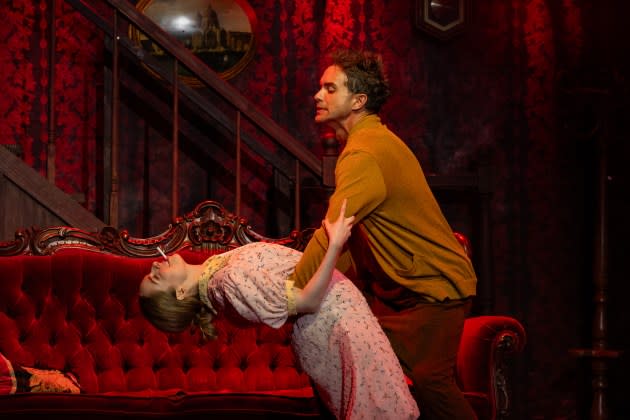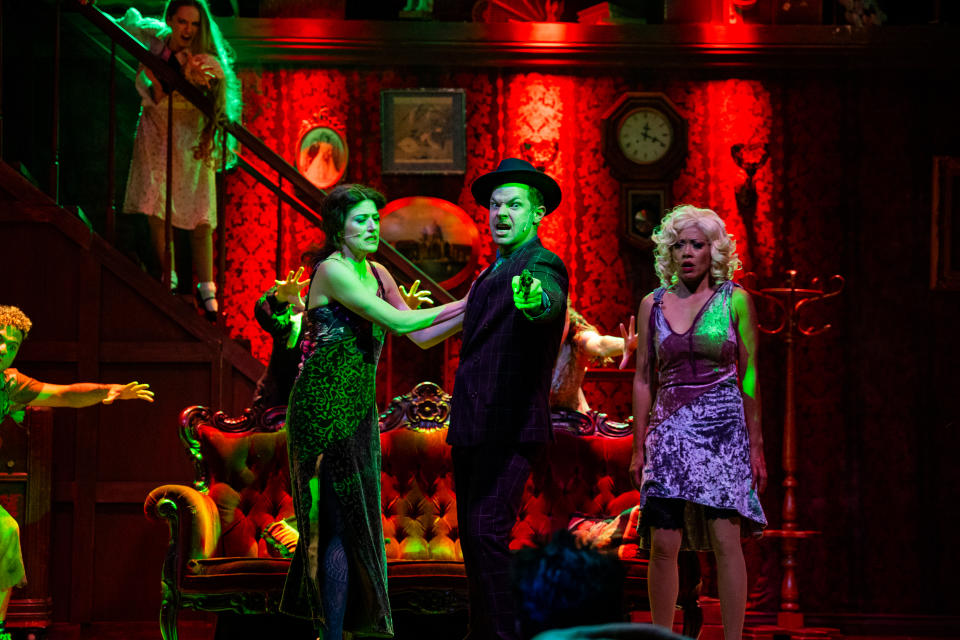‘Reefer Madness: The Musical’ Review: This L.A. Revival of the Weed-Themed Spoof Doesn’t Bogart the Showbiz Razzle-Dazzle

A lot of bong water has passed under the bridge since “Reefer Madness: The Musical” first premiered at the Hudson Theatre on Santa Monica Blvd. in 1998. Like, legalization of the demon weed in most states… plus, about a million more camp musicals that have come down the pike since then, maybe lessening any obvious need to bring back a show satirizing long-bygone pot paranoia. Fortunately, though, the passage of a quarter-century has not done anything to diminish what a kick “Reefer” can be, at least when presented in a revival as expert as the one now being pushed at the Whitley on Hollywood Blvd.
You assuredly do not have to be a dope fiend, or even someone who’s ever celebrated 4/20 as a national holiday, to feel like your perspective on the dimensions of the room is shifting a little over the course of the show. That’s not a hemp-fueled illusion — it’s just a realization of how much Broadway-level singing and dancing has been deliriously packed into a rather small space. Earlier in this century, the Whitley was a house-music dance club called the King King, before turning legit for this production. Even with tables and chairs taking over the floor, though, there may not actually be much less dancing going on, thanks to a cast of about a dozen that is frequently executing some leggy high kicks in the aisles. If really close proximity to delightful choreography is your drug of choice, this may be the show for you.
Be forewarned, or pre-assured: some of that hoofing will be swing dancing, or jitterbugging, or tapping. The show is of course set in the 1930s, a la like the weed-whacking 1936 film that of the same name that became a cult classic on the midnight movie circuit in the ‘70s. Eventually the costuming and dancing become ludicrously anachronistic, and a leading lady who is Lindy-hopping in the initial scenes will inevitably end up bumping and grinding in contemporary bondage gear by the time all is said, done and smoked. The sheer variety of dancing styles is part of the fun. The director, Spencer Liff, was originally pegged to just serve as choreographer, back when this updated version of the show was being workshopped in New York prior to the pandemic. Normally, having the dance captain bumped up to do double-duty might be cause for a little hesitation, but giving Liff (“Head Over Heels,” “So You Think You Can Dance”) the reins has resulted in as giddy a treatment as this material is going to get.
The storyline remains as simple as the movie’s: Boy meets girl; boy meets blunt (and eventually girl does too); damnation ensues for the couple as well as the denizens of the drug den that ensnares them. Obviously everything is so over-the-top that it won’t be hugely detrimental to this basically cartoonish show if you don’t get too emotionally invested in the two “romantic leads.” But doggone it if Darcy Rose Byrnes isn’t so winsome as Mary Lane that I didn’t find myself getting angry at Anthony Norman, who plays the all-too-corruptible Jimmy Harper, for betraying her adoration. Byrnes is a real songbird, and literally wide-eyed in her innocence — part Mary Pickford, part Jeannette McDonald. (Eventually, she’s kind of a hopped-up Bettie Page, too.) Kristen Bell played this role off-Broadway in 2001, pre-TV fame, and went on to do the Showtime movie version a few years later, and she’s on board as one of the revival’s producers. Bell filmed a promo spot where she said that Byrnes is better in the role than she was, and you never want to be in the position of telling someone saying that that they’re right. But Byrnes feels born to sell the naivete and forlornless of her character’s “Lonely Pew,” with some soprano heft.
Casting is superb across the board, all the way to the last swing ensemble members (all of whom cycle through far more costume changes than you’d think possible for a show with this large a cast and this limited a backstage). As Jimmy, the chief pushover, Jimmy, Norman makes for a sympathetic enough nincompoop. Thomas Dekker has as much fun as anyone in the show, as Ralph Wiley, who preceded Jimmy as a victim initiated into the drug den, although he was a college boy when he succumbed. The visual gag about Ralph is that he continues to wears a letterman jacket throughout the show, as if he’d succumbed to drugs so quickly at some point in the past, he never had a chance to take it off, even though he’s now about as twitchy and servile an assistant to the villain as Dracula’s Renfield.
The two molls of the weed house, J. Elaine Marcos and Nicole Parker, both know how to do negligee-clad degradation — with Parker (“Mad TV,” Elphaba in the “Wicked” national tour) getting a standout number early on with “The Stuff,” a wry ode to the pull of addiction. (Her Mae character finally gets over being conflicted in time to pull a knife for some Grand Guignol business toward the climax.) The MVP among performers here is Bryan Daniel Porter, who does triple duty as the narrator, Jesus, and Jack, the slick drug lord. In the 2005 Showtime adaptation, Alan Cumming was the narrator (and he’s a producer on this production, but it makes more sense to have it played by someone who really feels like a square and a scold. Porter is definitely going for incongruity, though, when he plays Jesus in about the same swinging but stolidly dismissive way you’d expect Phil Hartman might have.

The original lyricist, Kevin Murphy, and music writer, Dan Studley, who collaborated on the book, have done still more fresh work on this production, which piles tweak upon tweak while preserving the original comedic ethos laid down in the late ‘90s. The biggest change is a streamlining that sees it condensed from a two-act show to an intermission-less 90 minutes, which feels like exactly the right length and frantic tempo, even if a few gems got sacrificed in the nip-and-tuck. It probably would not have hurt if the writers or Liff had cut “Listen to Jesus, Jimmy,” which isn’t all that hilarious and seems like a residual of an era when the show could coast a lot more on sheer naughtiness. But it’s also easy to imagine how upset some “Reefer” cultists might be if Christ didn’t make his customary cameo.
“Reefer Madness” is a popourri of musical styles, and it’s just as much fun in the early, innocent going — with “Romeo and Juliet” and “Down at the Ol’ Five and Dime” — as it is when everything gets venal. (Or at least you’ll think so, maybe, if you ever loved “Dammit Janet” as much as the rest of “Rocky Horror.”) By the time blood is spurting almost an hour and a half later, you may think of shows that came before (“Little Shop of Horrors”) or after (like “Re-Animator: The Musical,” or “Heathers: The Musical,” which Murphy also co-wrote, and which is sorely due for a proper L.A. reproduction). But if by now there are ways in which the wickedness of “Reefer” feels fairly familiar, that doesn’t really doesn’t dampen how efficiently this production delivers a mixture of frolic, mayhem and show-biz razzle-dazzle.
Is there a message to the “Madness”? Of course there is, although thankfully there’s not too much heavy-handedness to the script’s inherent homilies about fake news and American authoritarianism not just being a byproduct of the 1930s. If I’m not mistaken, there was also a much more subtle message built in, when the narrator talks about the ostensible framing device for what we’re seeing, as a New Deal-era, WPA-funded project designed to put actors to work. That aside may land with anyone in the industry who comes to see the show, who understands just how valuable it feels in this uncertain climate to see such a talented cast strut its stuff. That goes also for the work of the designers responsible for the set (Mark A. Dahl), enveloping speakeasy environment (Peter Wafer) and lighting (Matt Richter). Kudos, too, to music director David Lamoureux, who keeps the jumpin’ jive alive even as the doomed characters start to turn on, drop out and drop dead.
Best of Variety
Sign up for Variety’s Newsletter. For the latest news, follow us on Facebook, Twitter, and Instagram.

